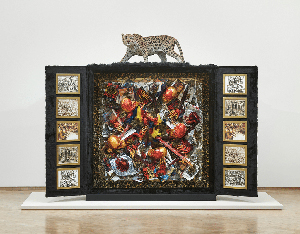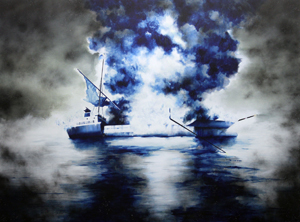Piano Man
John Haberin New York City
Raphael Montañez Ortiz
Puerto Rican Art After Hurricane Maria
Raphael Montañez Ortiz was not the first to destroy a grand piano, but he was surely the most determined. There he is, in performance at the Whitney, more than twenty years after his first act of destruction in 1966, still wielding his axe. The video opens his retrospective at El Museo del Barrio on just the right note. Its image of destruction makes more sense in light of Puerto Rican art in the wake of Hurricane Maria at the Whitney. It precedes surveys at El Museo of Juan Francisco Elso, Amalia Mesa-Bains, and their influence as well.
It takes commitment to rescue Ortiz, an artist better known for his activism and the museum that he helped bring into being in 1989. His art can easily seem a one-note affair. Search the Web for images, and you are likely to see little more than the piano man.  Think of it, though, as determination. Born in 1934, he wrote to advocate "destructivism" while still a student at Pratt. He was a student, too, in 1961 when he began to make sculpture by crushing and salvaging old clothing and chairs, blackened and browned by paint and by fire. He called them Archaeological Finds.
Think of it, though, as determination. Born in 1934, he wrote to advocate "destructivism" while still a student at Pratt. He was a student, too, in 1961 when he began to make sculpture by crushing and salvaging old clothing and chairs, blackened and browned by paint and by fire. He called them Archaeological Finds.
Commitment means political commitment as well, and it can make for some awfully solemn art. Ortiz and perhaps Fluxus aside (which had its debut in 1962 with a destructive performance in Berlin), piano destroyers have been composers or comedians, including Charlie Chaplin, Peter Sellers as Inspector Clouseau in the Pink Panther movies, and Harpo. No one would accuse Ortiz of an ear for music or a sense of humor. His most recent and striking sculpture amounts to a large cabinet, its sides hinged to open like the wings of a painted triptych. He called it The Memorial to the Sadistic Holocaust Destruction of Millions of Our Ancient Arawak-Taino-Latinx Ancestors Begun in 1492 by Columbus and His Mission to, with the Conquistadores, Colonize and Deliver to Spain the Wealth of the New World No Matter the Human Cost to the New World's Less Than Human Aborigine Inhabitants. Well, sure.
For Ortiz, nothing comes easily. Destruction takes work and the weight of an axe. Blow after slow, repeated blow barely makes a dent or a sound until, finally, the piano's bare, ugly remains leave a dark pile on the floor. Ortiz himself neither breaks a sweat nor cracks a smile. As a founder of El Museo, he has all of western culture to penetrate—as he liked to say, to release the evil. Only thus could he give Latin American art and Latin American history their due.
Alchemy and destruction
He was nothing if not determined. Harpo Marx destroyed a piano from sheer Romantic fervor, in one of the most triumphantly funny scenes in film history. Not Ortiz. For Harpo in A Day at the Races, pounding the keyboard releases his inner Rachmaninoff, and the Russian composer does the rest. White keys fly upward, and black keys sink inexorably below. The back end of the piano crashes down, and the strings slip to the floor—just in time for Harpo to rescue them, to stand them upright, and to continue his performance on them as a harp. The Marx brothers had already destroyed a theater and Verdi's La Traviata, in A Night at the Opera, so what else could a music lover do?
His "contextual retrospective" includes the work of others and some puzzling shifts in his art. His grace note exhausted, Ortiz started over more than once front scratch. He did so when he turned to sculpture, and he did so again in 2001 with digital paintings on vinyl. They have contemporary means, but their geometric abstraction is tired nonetheless. Bear in mind, though, the commitment. Art for him is too often "spurious" and still in need of "authentication."
The curators, Rodrigo Moura and Julieta González, follow "destruction art" with a section for "decolonization and guerrilla tactics." It includes pyramids and shields topped with feathers, in colorful but unconvincing homage to Mayan and Taino civilizations. It incorporates, too, old prints of the conquistadors in brutal action. They appear in the wings of the triptych, surrounding skeletal hands and skulls. The show's remaining sections, for "ethnoaesthetics" and "physio-psycho-alchemy," may not mean a whole lot by the sound of it to me or to you, but they do to the artist. For all the psychobabble, he is serious about overcoming "alienation" by releasing evil.
He also keeps asking: "for who does art exist"? And that points to another reason behind the stops and starts—collaboration with others and respect for their agenda. Ortiz worked alongside the Art Workers Coalition, the Guerrilla Art Action Group, the Young Lords, and Taller Boricua, whose photos ran not that long ago at El Museo. Do the stops and starts include political posters? The show includes additional posters by such stars as Faith Ringgold. His collage of model homes may not say all that much about affordable housing and fraudulent real estate, but Ortiz made them while Maria Teresa Hincapié in performance was emptying out her apartment.
The show includes another Puerto Rican American, Rafael Ferrer, but Ortiz is an active listener, and he listens to others as well. His constructions quote Pablo Picasso and Guernica. Their shattered browns and jagged remains appear in a standing figure in bronze by a Scottish artist, Eduardo Paolozzi. Destructivism shows the influence of Bruce Connor and Gordon Matta-Clark, who took a blowtorch to a Hudson River pier for Day's End. Born in Brooklyn, Ortiz grew up on the Lower East Side, where Puerto Rican families lived at odds with or close to orthodox Jews. He made his early black assemblages of nailed marshmallows and burnt shoes in remembrance of Treblinka.
The triptych itself is less dogmatic and discouraged than its title. Its skeletons are colorful to the point of cheerful, and a leopard prowls on top. The retrospective begins and ends with a less dour sort of destruction as well. As far back as 1957, Ortiz cut up cowboy movies and reassembled them without the heroism. More recently, he has added stuttering stop-action to family films. Is his art capable of planting a bomb? Maybe not, but a little girl leaves something dangerous behind in the living room.
The lingering storm
Count on Ortiz to take an axe to a piano again and again. Does it ever get a bit much? He has nothing on what his ancestral land has endured since 2017 alone. A hurricane, Covid-19, economic ruin, mass protests, an earthquake now and then—they have torn Puerto Rico apart literally and figuratively. Can hope or art survive? The Whitney looks at Puerto Rican art in the wake of Hurricane Maria, but the artists have their doubts.
 The show's very title has its doubts about survival, in a quote from Raquel Salas Rivera, the poet: "No Existe un Mundo Poshuracán," or "a post-hurricane world does not exist." The exhibition boasts of the first museum survey of Puerto Rican art in fifty years, even without Pepón Osorio, but you may have your doubts as well. Twenty artists with all of fifty works may not sound like much of an overview, but then they are not out for breadth. They focus on recent history and a present-day crisis. Many have lost loved ones to the hurricane, illness, and austerity, and they speak bitterly about what remains.
The show's very title has its doubts about survival, in a quote from Raquel Salas Rivera, the poet: "No Existe un Mundo Poshuracán," or "a post-hurricane world does not exist." The exhibition boasts of the first museum survey of Puerto Rican art in fifty years, even without Pepón Osorio, but you may have your doubts as well. Twenty artists with all of fifty works may not sound like much of an overview, but then they are not out for breadth. They focus on recent history and a present-day crisis. Many have lost loved ones to the hurricane, illness, and austerity, and they speak bitterly about what remains.
Sofía Córdova suggests the ambivalence shared by all, at dead center on an enormous screen. A car ride offers a breakneck tour of the island in sunlight, from deserted streets to poolside, but the video's narrators speak only of those weeks after the hurricane and an uncertain fate. Hand-me-downs from her father speak to Gabriella N. Báez of family ties, childhood pleasures, and suicide. Sofía Gallisá Muriente must assemble her past from found footage and home movies, with no priority to either one. Candida Alvarez can only transpose hers into abstract paintings, while Miguel Luciano has fragments of a school bus and the Puerto Rican flag as his only Shields. At the show's end, Elle Pérez returns to video and to those days without electricity, searching for beauty in the darkness.
Nature itself points both ways, to loss within a local habitation and a name. Sandstorms for Frances Gallardo become dark abstract prints. Photos by Javier Orfón document local foliage, but, in the work's title, he cannot recognize the dead. The human instinct for reflection and grieving serves no better. Funeral processions for Armig Santos become aimless crowds, where yellow flowers pierce cloudy layers of paint. They demand and preclude remembering.
The artists cannot confine their memories to five years either, and they direct their bitterness to the United States. Danielle de Jesus in paint remembers the mass shooting of protesters in 1937, while Gamaliel Rodríguez looks back all the way to the Spanish American War, in drawings that look like atomic explosions. Rogelio Báez Vega has no trouble remembering the modern architecture that still stands, often empty—in photos behind sickly vegetation on the museum floor. Gallisá Muriente treats corporate tax breaks and the tourist industry on equal terms, in burnished imagery on video. Yiyo Tirado Rivera treats tourism and climate change on equal terms, too, pairing a sandcastle hotel with a photograph of beach erosion, sad and glorious in rust red. Gabriella Torres-Ferrer shows her disdain for a nonbinding vote for statehood, with a campaign sign draped over a fallen lamppost.
Bitterness can take one only so far toward art or redemption. Torres-Ferrer should make her case to the many in favor—and to progressives everywhere who would relish two senate votes and an edge in the electoral college. Come to think of it, that modern architecture, with bows to native tradition, does not look half bad, and the Whitney thrives on tourism, too. The curators, Marcela Guerrero with Angelica Arbelaez and Sofía Silva, reserve a final room for protests, like political posters by Garvin Sierra Vega, but there, too, a sense of failure overwhelms the power of hope and anger. At its best the poignancy of memory conveys the urgency of the present. A wrought-iron fence by Edra Soto would convey both even without its peepholes onto a slideshow, of community and nature's growth.

Raphael Montañez Ortiz ran at El Museo del Barrio through September 11, 2022, Puerto Rican art after Hurricane Maria at The Whitney Museum of American Art through April 23, 2023.




